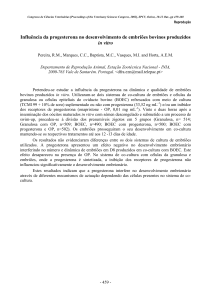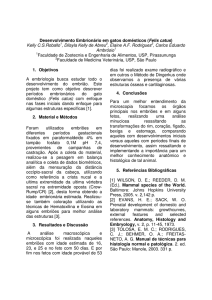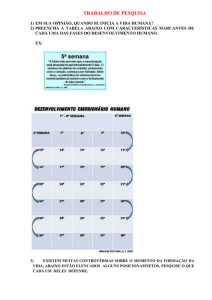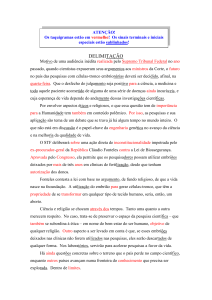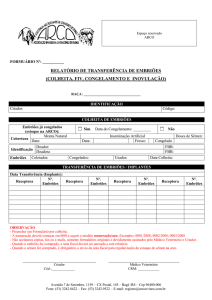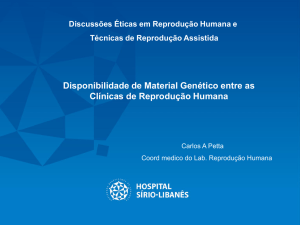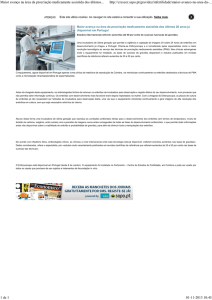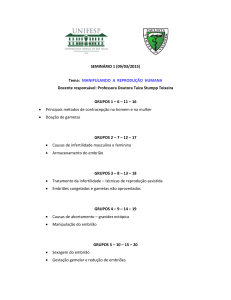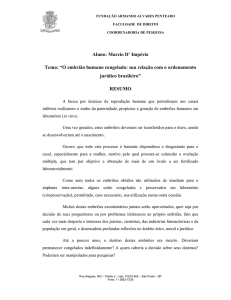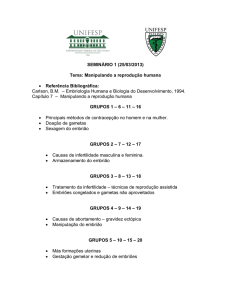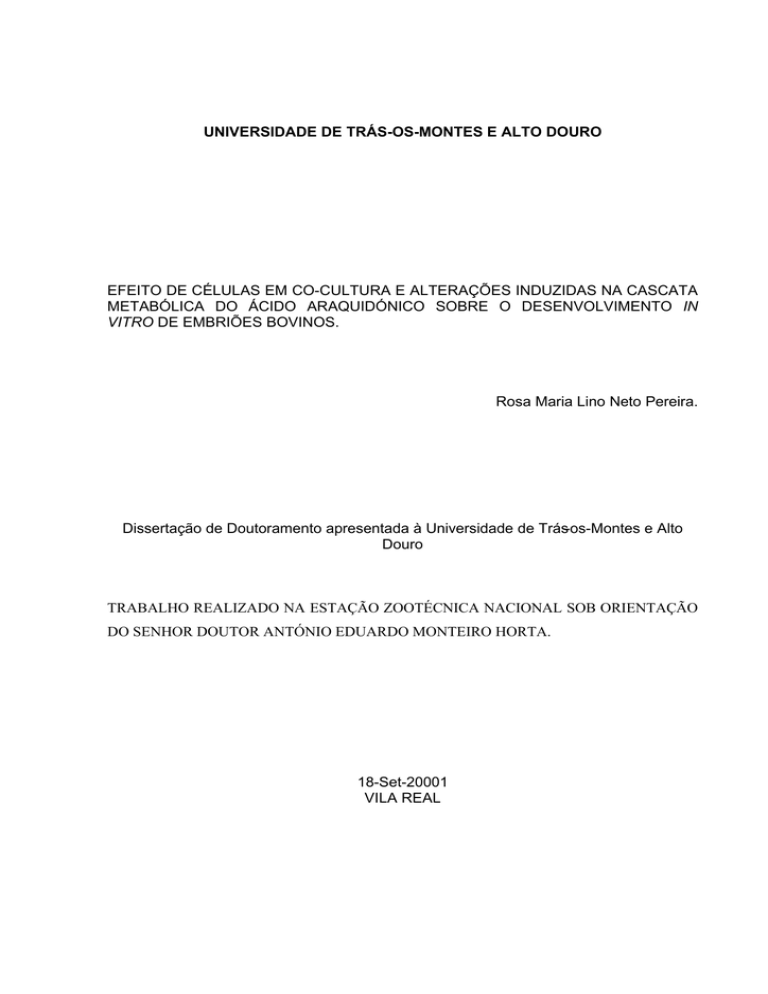
UNIVERSIDADE DE TRÁS-OS-MONTES E ALTO DOURO
EFEITO DE CÉLULAS EM CO-CULTURA E ALTERAÇÕES INDUZIDAS NA CASCATA
METABÓLICA DO ÁCIDO ARAQUIDÓNICO SOBRE O DESENVOLVIMENTO IN
VITRO DE EMBRIÕES BOVINOS.
Rosa Maria Lino Neto Pereira.
Dissertação de Doutoramento apresentada à Universidade de Trás-os-Montes e Alto
Douro
TRABALHO REALIZADO NA ESTAÇÃO ZOOTÉCNICA NACIONAL SOB ORIENTAÇÃO
DO SENHOR DOUTOR ANTÓNIO EDUARDO MONTEIRO HORTA.
18-Set-20001
VILA REAL
RESUMO
O desenvolvimento experimental desta tese contemplou diferentes objectivos. Pretendeuse desenvolver um sistema de cultura in vitro de células trofoblásticas em monocamada e
caracterizar o seu padrão de crescimento. Procedeu-se à avaliação da capacidade deste sistema
no suporte do desenvolvimento de embriões bovinos produzidos in vitro (IVP), comparando-o
com a co-cultura de embriões e células da granulosa. Testou-se também a suplementação dos
meios de cultura com prostaglandinas (PG) e seus precursores e inibidores, numa tentativa de
optimizar as condições de cultura dos embriões IVP e estudar os mecanismos fisiológicos que
controlam o desenvolvimento embrionário antes da implantação.
Foram encontradas diferenças no comportamento em cultura das células trofoblásticas e
da granulosa, utilizadas na produção dos embriões IVP. O transporte dos placentomas a 4º C
melhora significativamente a viabilidade das células trofoblásticas obtidas após a digestão
enzimática dos cotilédones fetais (68,94%), relativamente ao transporte a 37º C (55,59%) ou em
gelo (54,12%). Esta viabilidade inicial é superior à das células da granulosa obtidas de ovários
transportados a 4º C, mas enquanto que nas células placentárias, uma viabilidade inicial reduzida
compromete a sua recuperação ao longo da cultura, nas células da granulosa essa recuperação
existe. O SOCS prejudica a formação das monocamadas de células placentárias, ao contrário das
monocamadas da granulosa, onde este soro estimula a proliferação e diferenciação celular.
Também a organização e resistência das culturas difere entre estas células, apresentando as
monocamadas de células placentárias uma organização frágil pouco aderente à placa de cultura.
Pelo contrário, as células da granulosa formam monocamadas muito resistentes e aderentes entre
si e à placa e, em cultura, diferenciam-se exibindo características de células lúteas. A produção de
progesterona (P4) pelas células da granulosa em presença do ácido araquidónico (AA),
indometacina, indometacina com PGE2 (I+PGE2) ou PGF2α (I+PGF2α) não apresenta
diferenças significativas para cada dia de cultura (Dc) entre células tratadas e não tratadas. No
entanto, enquanto na testemunha, a síntese de P4 aumenta significativamente ao longo da cultura
(3,3 e 41,9 ng/mL, em Dc0 e Dc14; P=0,005), nas células tratadas com AA, as concentrações de
P4 não diferem entre si para qualquer dia de cultura (2,6 e 26,9 ng/mL, em Dc0 e Dc14; P>0,05).
Na presença da I+PGE2 existe um efeito luteotrófico precoce logo em Dc3, com uma produção
de P4 significativamente superior à de Dc0 (36,6 e 1,4 ng/mL, P=0,005). No grupo Indometacina,
esta superioridade só ocorre em Dc8 (33 e 1,4 ng/mL, P=0,01). A PGF2α não foi luteolítica,
apresentando o grupo I+PGF2α, de forma idêntica à testemunha, valores de P4 em Dc4
significativamente superiores a Dc0 (38 e 1,4 ng/mL, P=0,003 e 30,4 e 1,4 ng/mL, P=0,02,
respectivamente). A presença de embriões em co-cultura com as células da granulosa tem um
efeito luteotrófico, aumentando significativamente a produção de P4 a partir de Dc4. Esta
produção apresenta uma curva bifásica com um aumento até Dc4-5, seguindo-se um período de
estabilização, para voltar a aumentar a partir de Dc11 até ao fim da cultura. Quando o AA, a
indometacina, a I+PGF2α ou I+PGE2 são incorporados no meio de cultura, o perfil da curva da
síntese de P4 pelas células da granulosa em co-cultura com os embriões é alterado. O estadio e
qualidade dos embriões parecem ter uma acção preponderante no segundo aumento de P4 que
diminui na presença do AA e desaparece na da indometacina, da I+PGF2α e da I+PGE2,
alteração associada a diferenças induzidas por estes tratamentos no desenvolvimento
embrionário.
Avaliou-se a capacidade das células trofoblásticas da placenta para suportarem o
desenvolvimento embrionário. Os oócitos, 22 horas após a inseminação (D0=dia da
inseminação), foram transferidos para as monocamadas de células, tendo sido realizado um 1º
ensaio, com células placentárias na 1ª semana de cultura em monocamada, um 2º, com células
placentárias na 2ª semana de cultura, suplementadas com SOCS a partir de Dc2 ou Dc8 -9, e um
3º e 4º ensaios com diferentes concentrações iniciais de células placentárias (1 ×106, 5×105 e
2×105 células /ml), sendo todos comparados com os resultados da co-cultura dos embriões e
células da granulosa. Verificou-se uma melhoria das condições proporcionadas aos embriões
quando cultivados com células placentárias já na 2ª semana de cultura e, em meio com SOCS
apenas a partir de Dc8-9. No entanto, mesmo na 2ª semana de cultura, a s células placentárias
utilizadas para suporte do desenvolvimento embrionário apresentam um desempenho idêntico às
da granulosa durante as primeiras fases desse desenvolvimento (clivagem a mórulas), mas
inferior nos estadios mais avançados (taxa e qualidade dos embriões em D8, taxa de extrusados e
atraso no desenvolvimento embrionário).
Estudou-se a influência da incorporação de AA e PG nos meios de cultura sobre o
desenvolvimento embrionário. O AA apresenta uma acção bifásica, positiva no desenvolvimento
dos embriões até ao estadio de mórula, prejudicando o desenvolvimento posterior. Este prejuízo é
superior nas co-culturas com células da placenta, com grande redução da formação de blastócitos
(BL) e BL expandidos, ausência de embriões extrusados e embriões de pior qualidade. Nas coculturas com células da granulosa, o AA prejudica a taxa de embriões extrusados e induz um
atraso no desenvolvimento embrionário logo a partir de D7. Os efeitos negativos do AA
desaparecem quando este é adicionado apenas até aos 3 dias de idade dos embriões. A inibição da
lipo-oxigenase e da ciclo-oxigenase altera a taxa de clivagem dos zigotos apontando para a
importância de ambas as vias de metabolização do AA nesta fase do desenvolvimento
embrionário. A presença da indometacina prejudica a qualidade e eclosão dos embriões em todos
os ensaios, interferindo desta forma na dinâmica do desenvolvimento embrionário, reforçando a
importância da PG neste desenvolvimento. A suplementação dos meios de cultura de embriões
com PGE2 teve um efeito positivo na clivagem e na qualidade dos embriões. Apresentou, no
entanto, uma descida nas taxas de embriões entre D7 e D8, com menos BL nesses dias. A PGE2
associada à indometacina também teve um efeito positivo na clivagem e eclosão dos embriões e,
negativo, nas taxas de embriões em D7 e, sobretudo, em D8. A presença da indometacina com
prostaciclina influenciou positivamente as taxas de clivagem, de embriões D7 e D8 e, a da
indometacina com PGE1, não interferiu na clivagem, mas afectou positivamente as taxas de
embriões em D7, D8 e extrusados. Pelo contrário, a adição de indometacina com PGF2α
prejudicou a clivagem e as taxas de embriões em D7 e D8. Provocou ainda um atraso no
desenvolvimento embrionário e embriões de pior qualidade. Parece assim que as PG são
essenciais ao desenvolvimento embrionário precoce, variando a sua síntese e efeitos em função
dos estadios desse desenvolvimento.
Os resultados das experiências realizadas permitem algumas conclusões sobre as
diferenças no comportamento das culturas de células trofoblásticas e da granulosa e a sua
influência na produção de embriões IVP. Permitem também concluir da importância das vias
metabólicas do AA na luteinização das células da granulosa e no controlo fisiológico do
desenvolvimento embrionário precoce.
SUMMARY
The experimental design of this thesis had different objectives. One of the aims was the
development of an “in vitro” culture system of trophoblastic cells in a monolayer and to
characterise their development pattern. It was evaluated the capacity of this system in support of
the development of bovine embryos produced “in vitro” (IVP), comparing it with the co-culture
of embryos and granulosa cells. It was also tested the supplementation of the culture media with
prostaglandins (PG) and its precursors and inhibitors, trying to optimise the culture conditions of
the IVP embryos and studying the physiological mechanisms that control the embryonic
development before implantation.
Differences were found in the behaviour of the trophoblastic and the granulosa cells in
culture, used in the production of IVP embryos. The transport of the placentomas at 4º C
improves significantly the viability of the trophoblastic cells obtained after enzymatic digestion
of the foetal cotyledons (68,94%), compared with the transport at 37º C (55,59%) or in ice
(54,12%). This initial viability is higher than the granulosa cells obtained from ovaries
transported at 4º C, but while in the placental cells a reduced initial viability compromise its
recovery during culture, in the granulosa cells that recovery occurs. The SOCS damages the
formation (building) of the placental cells monolayers, contrary to the granulosa monolayers
where this serum stimulates cellular proliferation and differentiation. Also the organisation and
resistance of cultures differ among these cells, presenting the placental cells monolayers a fragile
organisation less adherent to the culture plate. On the contrary, granulosa cells form monolayers
very resistant and adherent among them and to the plate and, in culture, they differ exhibiting
characteristics of luteal cells. Progesterone (P4) production by granulosa cells in the presence of
arachidonic acid (AA), indomethacin, indomethacin with PGE2 (I+PGE2) or PGF2α (I+PGF2α)
doesn’t show significant differences for each day of culture (Dc) between treated and non-treated
cells. While in the witness sample the synthesis of P4 increases significantly during the course of
the culture (3,3 and 41,9 ng/mL, in Dc0 and Dc14; P=0,005), in the cells treated with AA, the P4
concentrations don’t differ among them in any day of the culture (2,6 and 26,9 ng/mL, in Dc0
and Dc14; P>0,05). In the presence of I+PGE2 there is an early luteotrophic effect as soon as
Dc3, with a P4 production significantly higher than in Dc0 (36,6 and 1,4 ng/mL, P=0,005). In the
Indomethacin group this superiority only occurs in Dc8 (33 and 1,4 ng/mL, P=0,01). PGF2α
wasn’t luteolitic, presenting group I+PGF2α, in a similar way of the witness, values of P4 in Dc4
significantly higher than Dc0 (38 and 1,4 ng/mL, P=0,003 and 30,4 and 1,4 ng/mL, P=0,02,
respectively). The presence of embryos in the co-culture with granulosa cells has a luteotrophic
effect, increasing significantly the production of P4 from Dc4. This production shows a twophase curve with an increase till Dc4-5, followed by a stabilisation period, increasing again from
Dc11 till the end of the culture. When AA, Indomethacin, I+PGF2α or I+PGE2 are incorporated
in the culture medium, the profile of the synthesis curve of P4 by the granulosa cells in the same
culture with the embryos is changed. The stadium and quality of the embryos appear to have a
preponderant action in the second increase of P4 that decreases in the presence of AA and
disappears with Indomethacin, I+PGF2α and I+PGE2. This change is associated to the
differences caused by these treatments in the embryonic development.
The capacity of the placenta trophoblastic cells to support embryonic development was
evaluated. Oocyts, 22 hours after insemination (D0=insemination day), were transferred to the
cells monolayers. A 1st assay was carried out with placental cells in the first week of culture in
monolayer, a 2nd with placental cells in the second week of culture, supplemented with SOCS
from Dc2 or Dc8-9, and a third and fourth assays with different initial concentrations of placental
cells (1×106, 5×105 and 2×105 cells/ml), having all been compared with the results of the embryos
co-culture with granulosa cells. Already in the second week of culture there was an improvement
of the conditions afforded to the embryos when cultivated with placental cells, and in the medium
with SCOS only from Dc8-9. However, even in the second week of culture, the placental cells
used to support the embryonic development show an identical performance to those of the
granulosa during the first stages of that development (cleavage to morula), but inferior in the
more advanced stages (rate and quality of the embryos in D8, rate of extruded and delay in the
embryonic development).
The influence of the incorporation of AA and PG in the embryo culture media in their
development was studied. AA shows a two-phase action, positive in the development of the
embryos till the morula stage, harming the rest of the development. This damage is higher in the
co-cultures with placenta cells, with a great reduction in the blastocyts (BL) formation and
expanded BL, absence of extruded embryos and worst quality embryos. In the co-cultures with
granulosa cells, AA damages the extruded embryo rate and causes a delay in the embryonic
development as soon as D7. The negative effects of AA disappear when this one is added only
until 3 days of age embryos. Inhibition of lipo-oxygenase and cyclo-oxygenase changes the
zygote cleavage rate, pointing the importance of both metabolization ways of AA in this phase of
embryonic development. Presence of indomethacin harms the embryo quality and eclosion in all
assays, interfering in this way in the embryonic development dynamic, reinforcing the
importance of PG in this development. Supplementation of the embryo culture media with PGE2
had a positive effect in the embryo cleavage and quality. However it presented a decrease in the
embryo rates between D7 and D8, with less BL in those days. PGE2 associated with
indomethacin also had a positive effect in embryo cleavage and extrusion, and a negative one in
D7, and mostly in D8 embryo rates. Presence of indomethacin with prostacyclin influenced
positively the embryo cleavage rates and embryo rates in D7 and D8, and indomethacin with
PGE1 didn’t interfere in the cleavage but affected positively the embryo rates in D7 and D8 and
extruded. On the contrary, adding indomethacin with PGF2α damaged cleavage and embryo rates
in D7 and D8. It caused a delay in the embryonic development and worst quality embryos. So it
seems that PG are essential to the early embryonic development, varying their synthesis and
effects with the stages of that development.

